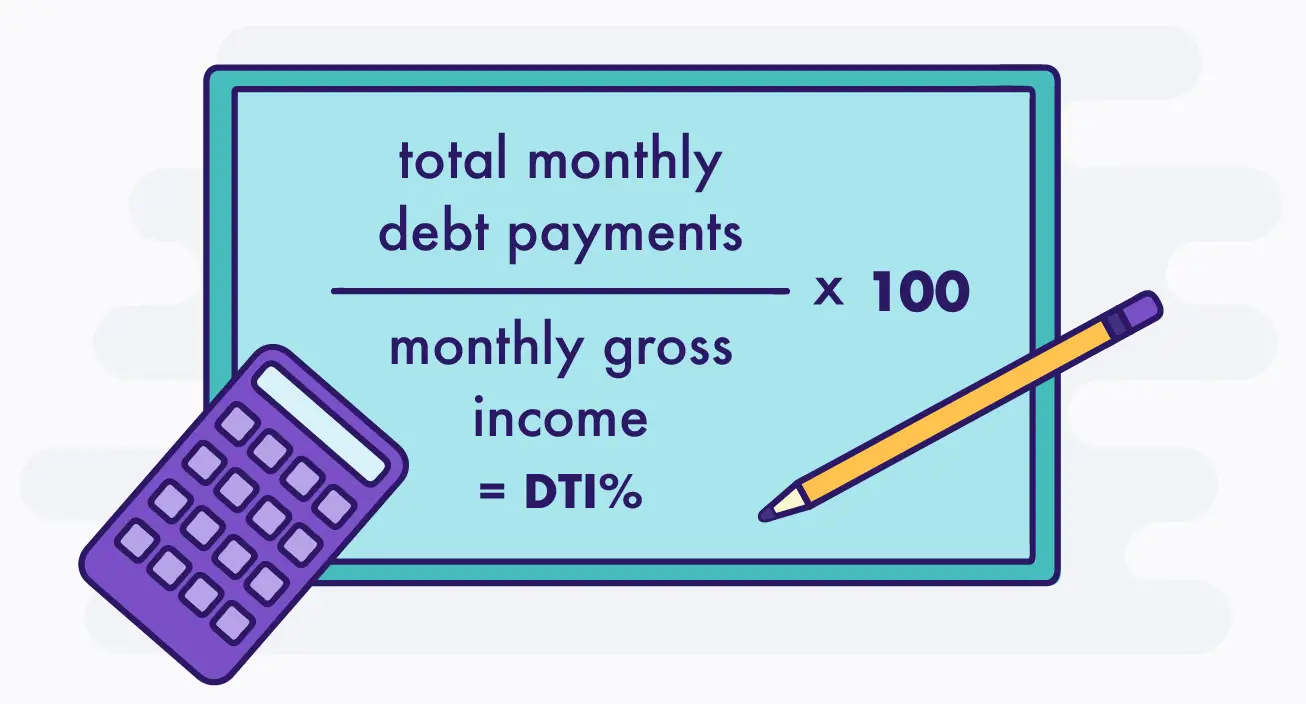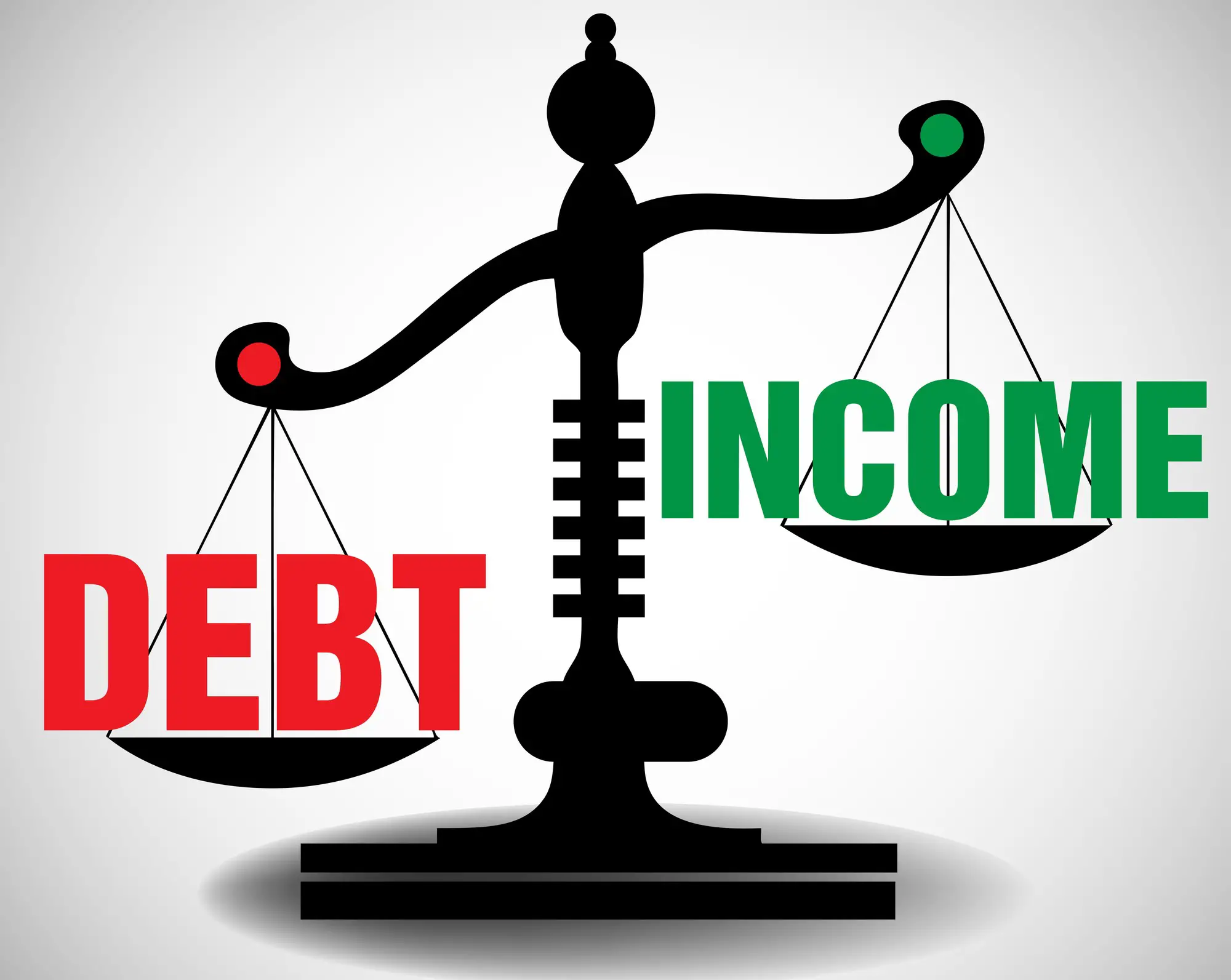The debt to income ratio (sometimes referred to as DTI) is an important number to lenders.
Some people claim it’s as important as your credit score in determining whether your application for a home loan or credit is accepted or not.
Your debt to income ratio shows your ability to repay the debts you’ve incurred based on your overall income.
Contents
What is a Debt to Income Ratio?
The definition of the debt to income (DTI) ratio is your total monthly debt payments divided by your monthly gross income.
The debt to income ratio formula is as follows:

Now that you know what a DTI ratio is, you’re probably asking yourself: what is my debt to income ratio?
How to calculate Debt to Income (DTI) Ratio?

I’m going to show you how to figure out your own debt to income ratio by walking through a hypothetical calculation for Mary.
Take out a piece of paper and a pencil and follow along.
Remember, the debt to income ratio formula is total monthly debt payments divided by your monthly gross income.
First, we need to figure out your monthly gross income. This is your income before taxes or any other deductions are taken out.
If you have one source of income, then it’s an easy number to figure out. Just look at your most recent pay stub for your gross income per paycheck and multiply that by how many times you get paid a month.
Mary makes $2,500 per paycheck before taxes and before his contribution to his 401k. She gets paid twice a month. St Mary’s monthly gross income is $5,000 ($2,500 X 2).
Next, we need to figure out your total monthly debt payments. This number is a little harder to figure out if you have multiple types of debt.
For each type of debt listed below, write down the minimum monthly payment on a piece of paper.
- Credit card payments
- Mortgage (including interest payments, insurance, and property taxes)
- Home equity payments
- Car loan
- Student loans
- Any other type of loan you may have
Once you have all the monthly minimum payments listed, just add them up to get your total monthly debt obligation.
Mary’s minimum credit card payments are $212 and $138. Her mortgage, including insurance and taxes, is $1300. Her car loan costs him $250 a month.
If we add all those numbers up, we’ll figure out that Mary has a total monthly debt payment of $1,900.
So now that you have your gross monthly income and your total debt payment amount, just divide your debt number by your income number to get your debt to income ratio.
Mary’s debt to income ratio is 1900 / 5000 = 0.38. Multiply that by 100 to get a percentage and Mary has a debt to income ratio of 38%.
What is your debt to income ratio?
If you don’t want to do your calculation by hand, you can use this debt to income ratio calculator.
Now that you know your DTI ratio, what does it mean and how do you compare to others?
What is a good Debt to Income Ratio?
Many studies on mortgage loans have shown that people with higher debt to income ratios are more likely to have issues paying their debts off.
This is intuitive – the more you owe the less likely it is you can pay it off. Therefore a low debt to income ratio is desirable when seeking a mortgage or applying for credit.
Unlike a credit score, there are no cut-offs that determine what a “good” or “bad” debt to income ratio. You should always seek to lower your debt to income ratio by earning more money or by paying off your debts faster.
What’s a Good Debt to Income Ratio for getting a mortgage (Home Loan)?
While there is no concrete “good” debt to income ratio, there are some concrete numbers to keep in mind when applying for a home loan.
Lenders like to see a debt to income percentage under 36% where no more than 28% of that debt goes towards paying your mortgage.
So far, the calculation we’re using is to determine the “back-end debt to income ratio” which is different from the “front-end debt to income ratio”.
The back-end ratio uses your total debt obligations. The front-end ratio uses only your mortgage debt obligations (interest, principal, housing taxes, PMI, etc).
The 36% number mentioned above is the back-end debt to income ratio. The 28% number is the front-end debt to income ratio.
There is a maximum debt to income ratio when applying for a mortgage. When applying for an FHA loan a back-end debt to income ratio of 43% is the maximum ratio you can have and still get a Qualified Mortgage.
The VA and USDA back-end debt to income ratio limit is 41%.
There are a few exceptions to this rule, but if you do have a debt-to-income ratio higher than 43% you should really ask yourself if the loan or credit is worth the risk.
What’s a Good Debt to Income Ratio When Applying for a Car Loan?
Applying for a car loan is not much different than applying for a home loan. Lenders still like to see that your total debt to income ratio is under 36%.
Unlike with your home loan, you don’t want the debt servicing your car loan to be anywhere near 28%.
What Does Debt To Income Ratio Tell You?

The DTI tell us about the ratio of our monthly earnings and debt that has on that earnings. The lower DTI ratio suggests that we have little debt on income.
However,
The high debt means you have too much debt on your monthly earned income.
Debt To Limit Ratio:
A ratio that is used to calculate one’s credit score is consulted as a debt to limit ratio. The debt to limit ratio is generally referred to as managing a credit balance.
It is the ratio of the revolving credit which is you are using to the total amount of credit that is available to the individual.
Furthermore,
The debt to limit ratio has a great impact on the individual credit score. The individual creditworthiness is assessed by the lenders in the debt to limit ratio.
Want to know what is the key concept?
With acquisitions and expenses the individual’s debt to limit ratio may fluctuate i:e they move up and down.
Calculation Formula:
Debt to limits is a term coined to explain the ratio between the amount that you be obligated to your mortgagees to the total credit you gained or the credit limit.
It can be calculated by using the formula
Debt to limit=(Revolving credit you are using/Total amount of credit available)*100
What Does Debt To Limit Tell You?
As the debt to limit spins around the concept of utilizing the revolving credit by the total amount of credit you own.
It is important to consider what is a high debt to limit and vice versa.
Your specific credit situation decides whether the ratio is high or low and the more the credit card you add the greater will be the effect on your credit score.
To avoid the negative impact on the credit score finance people recommend that one should not use more than 30% of the credit that is available.
DTI VS Debt To Limit Ratio:

However, these two systems of measurement have different in so many ways but sometimes the DTI and debt to limit ratio share the same brain or contemplate as identical rather than one by one.
DTI is a method of measuring or assessing your debt and the gross or total income that you acquire monthly.
It gives the creditor a view that whether or not an individual is making enough money that can make the payments of debt.
Conversely,
The debt to limit ratio is the ratio that includes credit cards and the limits of credit cards. To improve the credit score one should use a debt ratio below 30%.
How To Lower Debt To Income Ratio?
The following steps should be taken to lower the DTI if your DTI is approaching or is more than 36%.
- If you increase the amount that you pay monthly to debt then it can increase the chance of lowering your DTI cause it helps to cover your overall debt payment more rapidly.
- Don’t take another debt if you want to lower your DTI.
- To use less credit stop doing large acquisitions. By doing this you can manage to do larger down payments and hence result in lower DTI.
- To decrease the debt to income ratio one should try to increase the gross income.
Closing:
All and all, it is important to understand the key concept of these two and their relativeness with you and your fiscal life.
No matter you have less debt or more debt, high payments, or low payments you should keep both of these ratios as minimum as you can because it will affect your financials.
The lower the ratio the more financially strong you will be. To boost your credit score it is quite important to keep these two ratios as low as you can.
What is your debt to income ratio? And how do you plan on lowering it? I would love to know your answers.

For less than 5 minutes of your time, earn yourself a random stock whose value is anywhere between $5.00 and $200. It is possible through an investing app called Robinhood.